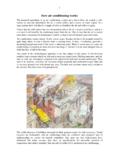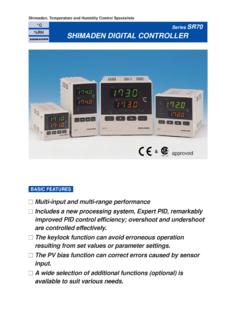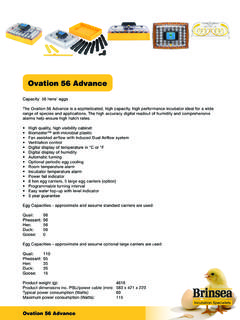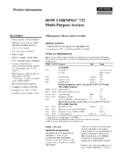Transcription of Simple climate control in archives is hindered by …
1 Simple climate control in archives is hindered by too strict standardsTim archive , BS5454:2000, humidity , temperature, : There is now abundant built evidence that archives can sustain a moderate relative humidity and temperature by warming, or by dehumidifying. Four examples of museum storage buildings, of diverse purpose, size and location, show adequate climatic stability without air conditioning. However, it is not possible without air conditioning to conform with the strict temperature limits recommended in the widely used British Standard BS5454:2000, which, though an advisory standard, is often used as a building specification.
2 The strictness of this standard is not supported by evidence for chemical or physical damage if its limits are exceeded, yet deference to it hinders the building of low energy archives which are tolerant of loss of power and neglect. 1. Introduction There are many specialised buildings that require a degree of climate control that is not considered necessary in ordinary houses, or even in offices and factories. Museums and archives in particular are expected to have a constant climate , in both temperature and relative humidity , and to have pure air. One might think that the environmental requirements for these exotic buildings, always a tiny proportion of the total stock, are only of interest to a few specialists.
3 However, one can argue that a detailed study of these buildings provides valuable lessons for the construction of buildings for other purposes. In particular, this study illustrates the arbitrary limitations to energy efficiency set by standards of doubtful quality, and the physical limitations set by current building technology. 2. The tyranny of the standard A serious constraint encountered by the designer of an archive or museum is the specified indoor climate . I take as an example the British standard for archives BS5454:2000 [British Standard 2000]. This is an influential document.
4 Obeying it is obligatory for British archives [National archives 2004]. It has also been invoked in projects outside the UK, for example the storage building of the Royal Library in Copenhagen. It is also common for standards developed in temperate climates to be considered applicable in exotic climates, such as the Egyptian desert (St. Catherine's Monastery library, Sinai). The widespread use of the British standard is because the international standard, ISO 11799:2003, is not prescriptive, giving only general guidance which cannot be used as a specification because it contains no exact numbers.
5 It is the didactic nature of the British standard which has made it so influential. But is it right? Unlike scientific articles, the standard is anonymous its authors shelter behind the prestigious names of the participating organisations. Yet it claims to be based on scientific principles and findings. In its favour, the standard does not assert that the climate must be as it advises, but in practice the standard is used as a specification, with legal force. The standard recommendation is unattainable without air conditioning. I illustrate this assertion later, but first I describe the recommended climate and try to understand why it is so tightly constrained.
6 "The temperature set point must be between 16 C and 19 C with a tolerance of 1 C on either side, but ranging neither below the minimum nor above the maximum." This is tricky to achieve in any building, anywhere, even with air conditioning. "Relative humidity should be at a fixed point between 45% and 60% with a tolerance of 5% on either side, but ranging neither below the minimum nor above the maximum." Amazingly, this is easy to achieve in an archive , provided it is full of paper and cardboard boxes which buffer the relative humidity , and provided the air exchange rate is low.
7 Demonstrating a constant relative humidity in an empty archive room, which is necessary to persuade the client to take over the building, is another matter, considered in a later standard furthermore demands that "The air within the repository should not be stagnant". That forces the use of fans and consequently activates another demand: "If a mechanical ventilation system is provided it should be designed to reduce pollutant concentration by introducing a proportion of fresh air". Given that the temperature and RH are already so strictly defined, air movement surely has no significance.
8 Air movement itself has no reported effect on biological growth but it is customarily invoked as an indirect defence against fungal growth. Moving air serves to transport heat to cold surfaces, typically in corners of outside walls, where local low winter temperature results in a raised local RH. If the RH is as specified throughout the building, there is no need to avoid stagnant air. Indeed many archived papers are kept in boxes, thus ensuring stagnant air. A method of achieving the specified climate is elevated by the standard to an independent argument for introducing a portion of fresh air is unconvincing.
9 Clean air is a rare commodity, unknown in cities, where most archives are built, so pollutants are pumped into the archive . Pollution generated within the archive through outgassing from the furniture, and from the archived material, is a well known threat in museums. Morten Ryhl Svendsen [Ryhl Svendsen 2007a, 2007b] has shown that at least two air changes per hour is necessary materially to reduce the threat from internally generated pollutants, while it is possible to attain the same purity by recirculating the air through a carbon filter, without importing pollutants generated outside.
10 Two exchanges with outside air per hour will destroy the humidity buffering performance, which only works effectively at less than one air change every ten hours. The strict limits for temperature are designed to minimise the risk of condensation when papers are brought from the archive to a reading room at a congenial temperature for people. According to the standard, the narrow temperature range is "In order to avoid the need for acclimatization when documents move from storage to reading room and back,.." The upper temperature limit is still below the temperature of most reading rooms, so one need only consider the worst case, the archive lower limit at 16 C with a reading room in summer at 22 C and 60% RH.










